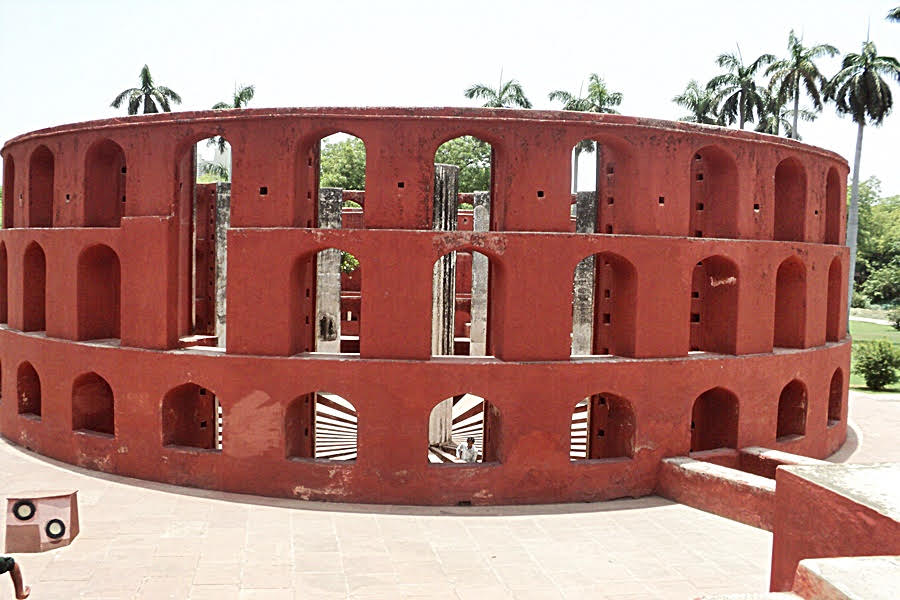
In a significant step toward preserving India’s scientific heritage, the historic Ram Yantra located at the Jantar Mantar observatory in New Delhi is soon set to undergo restoration. Notably, this Ram Yantra is nearly twice the size of its counterpart at the Jaipur observatory. The instrument was originally designed for measuring the altitude and azimuth of celestial bodies with remarkable precision.
Maharaja Sawai Jai Singh II of Jaipur (1688–1743) had constructed five major astronomical observatories across India—in Jaipur (Rajasthan), New Delhi (Delhi), Varanasi (Uttar Pradesh), Ujjain (Madhya Pradesh), and Mathura (Uttar Pradesh)—during the 18th century. Of these, only the observatories in Jaipur, Ujjain, and Varanasi are currently operational. The Mathura observatory has fallen into ruin, and its remnants barely survive today. Following a directive from the Hon’ble Supreme Court, the instruments at Delhi’s Jantar Mantar are now set to be restored.
These observatories were constructed for scientific observation of celestial phenomena, measuring time, planetary positions, and calendar calculations. Their massive stone instruments—such as the Samrat Yantra, Jai Prakash Yantra, and Ram Yantra—stand as marvels of ancient scientific architecture.
The Jaipur observatory, located near the City Palace in the heart of Rajasthan’s capital, is the largest and best-preserved among all five. Recognized as a UNESCO World Heritage Site in 2010, it was constructed between 1724 and 1734. The most prominent instrument at Jaipur is the Samrat Yantra—a 27-meter-tall sundial capable of measuring time with an accuracy of up to 2 seconds. Other notable instruments include the Jai Prakash Yantra (for reading celestial coordinates), the Ram Yantra (for measuring solar altitude and angle), the Nadi Valaya Yantra (for local time), and the Chakra Yantra (for measuring celestial coordinates). All are constructed from stone and marble. The Jaipur observatory remains a unique blend of Indian astronomy and architectural precision, attracting scientists and tourists alike.
The Jantar Mantar in New Delhi, located near Connaught Place, is surrounded by modern constructions. Adjacent to the observatory lies the ancient Batuk Bhairav Temple, a property of the Rajasthan Devasthan Department. Close by is the popular Janpath Handicrafts Market, frequently visited by domestic and international tourists. Unfortunately, some Rajasthan government properties in the area have been encroached upon. Additionally, the Jantar Mantar area is often a focal point for protests and demonstrations during parliamentary sessions.
Recently, Rajasthan Chief Minister Bhajan Lal Sharma visited the Batuk Bhairav Temple and surrounding sites, issuing necessary directives to officials.
The Ram Yantra slated for restoration is located to the south of the Samrat Yantra within the Delhi Jantar Mantar. This instrument was originally used to track the sun's movement. According to the Archaeological Survey of India (ASI), detailed documentation is underway ahead of the restoration. A recent meeting was held between a team of experts and the project architect to finalize plans. One committee member confirmed that marking and design drafts have been completed using computer-aided design technology.
The Ram Yantra can calculate the sun’s altitude at any time of the day and can even be used to determine local time. Presently, the upper 180-degree segment of the southern (secondary) structure is sealed, though it was originally constructed with open segments similar to its twin. The central vertical pillar’s engraved scale has completely eroded, leaving only faint traces. Similarly, the horizontal slab’s calibrated circular arcs have nearly vanished, and the radial lines spaced at 1-degree intervals are no longer visible.
Dr. Alok Pandya, Head of the Physics Department at Indira Gandhi National Tribal University in Amarkantak and a native of Banswara in southern Rajasthan, has emphasized the need for restoring and revitalizing the Ram Yantra. He stressed reopening the sealed segments as part of the project and re-engraving the central pillar’s evenly spaced stripes—visible in archival photographs. The instrument’s circular arcs and radial lines must also be redrawn and etched on the horizontal slabs of both structures.
The Ram Yantra consists of two large circular structures with evenly spaced apertures in their walls, together forming a complete cylindrical frame. Each has a vertical central pillar connected by flat slabs to the outer walls. These instruments were used to trace the sun’s trajectory. For instance, when the pillar’s shadow falls precisely at the base center of the wall, it indicates that the sun is at a 45-degree angle—midway between the horizon and the zenith.
In 2023, following directions from the Hon’ble Delhi High Court to assess the functionality of instruments at the Jantar Mantar observatory, the ASI constituted a six-member committee. This was reportedly in response to a contempt petition alleging slow compliance with a 2010 court order. However, with the Hon’ble Supreme Court now intervening, hope has been revived for the timely restoration of this historic site.
If completed as scheduled, the project will restore the glory of one of India’s significant scientific landmarks. More importantly, it will once again enable accurate naked-eye observations of celestial events, time measurement, planetary positions, and calendar computations—just as it did in the golden age of Indian astronomy.